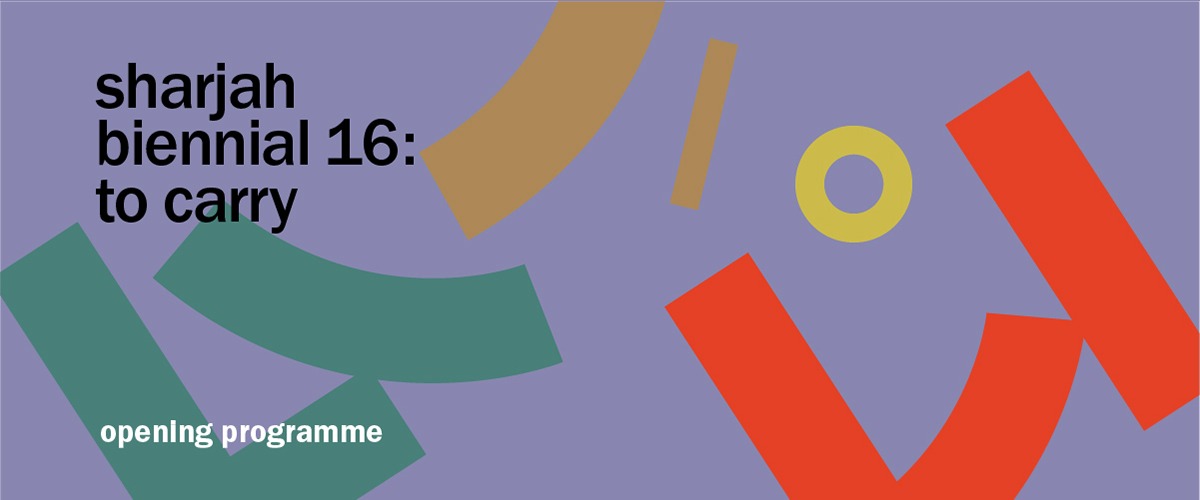IBA Stage: 9th Asian Art Biennial – Anne Davidian
5 February 2025IBA Stage: 9th Asian Art Biennial – Merv Espina
8 February 2025
Sharjah Biennial 16: to carry
February 6–June 15, 2025
Venues Throughout Sharjah
The highly anticipated Sharjah Biennial 16 (SB16) is set to launch on February 6, 2025, and will run until June 15, 2025, offering an exploration of what it means to carry—both physically and metaphorically. Curated by Alia Swastika, Amal Khalaf, Megan Tamati-Quennell, Natasha Ginwala, and Zeynep Öz, this edition of the Biennial will unfold across more than 17 venues in Sharjah City, Al Hamriyah, Al Dhaid, Kalba, Al Madam, and other locations across the Emirate of Sharjah.
The Biennial presents an programme featuring more than 650 works by nearly 200 participants, including over 200 new commissions. Through an intricate network of exhibitions, activations, performances, music, film screenings, and publications, SB16 invites audiences to reflect on questions of displacement, memory, adaptation, and resistance.
The curators, each with distinct processes and offerings, present their Biennial projects collectively and individually, allowing room for listening and processing. Through the artworks as well as workshops, publications, sonic experiences and other activities, they draw on their different approaches to spark conversations and share narratives from many geographies, languages and perspectives. Their diverse curatorial approaches come under the umbrella of a single question: What does it entail to carry a home, ancestors and political formations with you?
Alia Swastika focuses on the interplay of power, poetics, politics and the foundational role of women’s knowledge as well as the conception of speculative futures through technological intervention. Amal Khalaf proposes storytelling, song and divination as rituals for collective learning and resistance in times of political and environmental crisis. Working from an Indigenous standpoint, Megan Tamati-Quennell brings together poetic projects exploring concepts related to land, impermanence and speculative futures as well as reciprocity and respect. Natasha Ginwala centres littoral sites in the Indian Ocean and water wells in Sharjah as reservoirs that avow ancestral memory, place-making and sonic remembrance. Finally, Zeynep Öz turns a historical lens onto the societal and economic systems in which we participate, specifically those developed in response to accelerated changes in technology and science.
SB16 is structured around core themes that examine the ways in which individuals, communities, and cultures carry histories, knowledges, and traditions across time and space.
Among the communal themes addressed by the curators are oceanic crossings, regional affinities and cultural continuities, many considered within the context of Sharjah’s coastal geographies and maritime history. Mariam M. Alnoaimi’s work remembers the Gulf region’s relationships with water bodies as living entities and reperforms local rituals in sites affected by land reclamation. Approaching the littoral as a source of visual stories, Akinbode Akinbiyi’s photograph series Sea Never Dry (1982–ongoing) is spread along the corniche of Sharjah City as urban interventions. The garments, objects and public gestures created by SERAPIS MARITIME, a hybrid art, design and fashion entity, use materials and imagery from Sharjah’s shipyards and industrial facilities. Cassi Namoda’s paintings depict acts of labour and scenes of motherhood along the shoreline of Mozambique and Afro-Lusophone storytelling to attest to ancestral memory-keeping and matrilineal stewardship. Megan Cope’s sculpture Kinyingarra Guwinyanba (2024), meaning place of oyster rocks, is situated in Buhais Geological Park as a reference to deep geological time and the shallow sea that covered Sharjah millions of years ago.
As witnesses to environmental injustice and collapse, artists address their ties with colonial projects and reconfigure relationships through Indigenous knowledge systems and communal worlding. Speaking to the devastation of land and customary food sources, Yhonnie Scarce’s work, consisting of hundreds of hand-blown glass yams, recreates the radioactive rain clouds caused by the nuclear testing conducted by the British in Australia in the 1950s and 1960s. In her new work, Like a Flood (2025), Adelita Husni-Bey reflects on Libya’s failing water infrastructures, the ongoing impact of extraction during Italian colonisation, and the concept of climate adaptability. Alia Farid shares two works based on her multi-year research on ancient wetland communities in the southern marshlands of Iraq, which have been impacted by the aftermath of war and oil industries. Luana Vitra’s installation, pulling from the artist’s personal history of growing up in a mining state in Brazil, invites us to imagine a future devoid of mineral exploitation. The wheat patches and kinetic sculptures by Risham Syed entwine traditional practices from community kitchens, harvest cycles and Sikh philosophy amidst the planetary crisis of hunger and food insecurity. Betty Adii uses natural pigments sourced from the forest of her native Papua, which is facing threats of calamitous deforestation, while composer Septina Layan responds to Betty Adii’s work with voices of lamentation. Septina Layan will perform the lament during opening week at Kalba Ice Factory.
Knowledge, mythologies and political narratives carried by women artists manifest through different expressions in the Biennial. Building on her research about the Syrian Egyptian singer Asmahan who died in a mysterious accident in 1994, Helene Kazan attempts to reclaim feminist histories through song and poetic testimony. Faye HeavyShield, primarily informed by the art of the Canadian prairies and her personal history as a Senior Kainai artist and native Blackfoot speaker, presents two new works that extend from land, language and the body. Rajni Perera’s works feature femme hybrids and protagonists inspired by South Asian mythology and speculative cosmologies, embracing radical futurity and planetary turbulence. Womanifesto presents a quilted shelter-like structure produced by women’s communities all around the world, including one in Sharjah’s Al Madam, to offer a transnational space for women to share their stories and build platforms for solidarity.
Some artists hone in on technology, both old and new, to explore its economic and societal implications and its effect on global history. Blending humour and historical context, Akira Ikezoe presents paintings and a new animation, referring to nuclear accidents that have evaded humanity’s attempts at regulation. Pratchaya Phinthong transposes the future of ‘green energy’ to archaeological forms and experiments with solar energy to enhance coral growth in the reefs around Sharjah. Installed in a courtyard in Al Mureijah Square, Joe Namy’s sonic installation Dub Plants (2024–2025) probes the historically connected fields of radio culture and agriculture. Jorge González Santos revives primal technologies engaging fire, earth clay and plant knowledge to create a topography of mutual learning, and Fernando Palma Rodríguez, a mechanical engineer and pioneer of Indigenous robotic art, reclaims ancestral knowledge as a blueprint for a more sustainable future.
The Biennial foregrounds collective processes that forge new approaches to dialogue, collaboration and co-production. Under the name The Weaving Project, Güneş Terkol, Salima Hakim and Yim Yen Sum travelled together into villages in eastern Indonesia’s mountains to trace the ancient history of humanity and the tradition of weaving; their residency resulted in three distinctive new works. Raven Chacon collaborated with Bedouin singers for his site-responsive sound work in a deserted neighbourhood in Al Madam, originally constructed as public housing for a local tribe. Devised as an ‘open-ended’ process under common questions of personal transformation in the midst of daily political and social turmoil, Ayşe İdil İdil, Betül Aksu and Okyanus Çağrı Çamcı, with curator Merve Elveren, present their project Day to Day in two forms—a publication and an exhibition. Concrete Thread Repertoire, a project group composed of artists, researchers and communities based in Indonesia, assembles an archive of political action and resistance in various states of emergency. Bilna’es, an ‘adisciplinary’ platform invested in generating new models of resource distribution, presents a vinyl publishing project, a group exhibition about debt and a musical performance, which will take place during opening week.
Different sonic experiences form foundational moments in this Biennial, which is multivocal at its core. Michael Parekōwhai’s He Kōrero Pūrākau mo Te Awanui o Te Motu: Story of a New Zealand river (2011), a carved and playable Steinway concert grand piano, invites different music communities to perform. In addition to Bilna’es’ vinyl, other Biennial vinyl projects include a work by Aotearoa New Zealand musician and sound artist Mara TK and The Ancestral Well: Pulse to Terrain, an album conceived by Natasha Ginwala and Sarathy Kowar. Zeynep Öz’s YAZ Publications, a series of 13 books created in parallel with her Biennial exhibition, inspires an aural form in Al Dhaid, where six sound artists respond to the presence or lack of trees, water and irrigation systems in a former date orchard.
Sharjah Biennial 16 transforms contemporary art into a multivocal space for storytelling, collective memory, and futurity. By convening a diverse array of artists, scholars, and cultural practitioners, SB16 offers a dynamic forum to navigate histories of displacement, resilience, and adaptation.
For those of you travelling in the occasion of the biennial’s opening days, February 6th to 9th find a link to the full program here.
The Biennial is free and open to the public. For more details, visit sharjahart.org and follow SB16’s journey on Instagram, Facebook, and Twitter.




